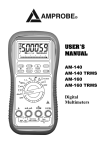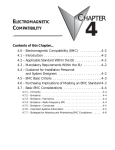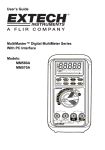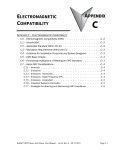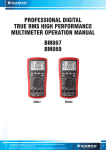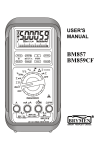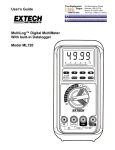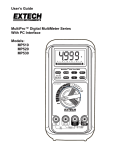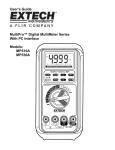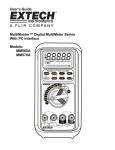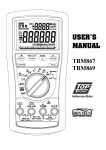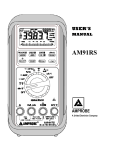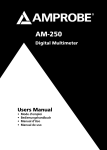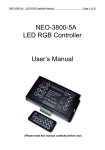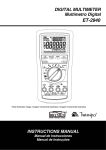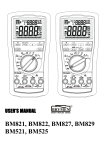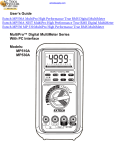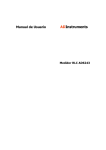Download Amprobe AM-150 TRMS Multimeter Manual PDF
Transcript
USER'S MANUAL AM-120 TRMS AM-130 TRMS AM-150 TRMS Digital Multimeters 1 This manual is applicable to all meter protection versions or otherwise specified 1) SAFETY Terms in this manual WARNING identifies conditions and actions that could result in serious injury or even death to the user. CAUTION identifies conditions and actions that could cause damage or malfunction in the instrument. This manual contains information and warnings that must be followed for operating the instrument safely and maintaining the instrument in a safe operating condition. If the instrument is used in a manner not specified by the manufacturer, the protection provided by the instrument may be impaired. The meter is intended only for indoor use. The meters (all versions) are protected by double insulation per EN61010-1 and IEC61010-1 2nd Edition (2001) to CAT III 1000V & CAT IV 600V. The meter (all versions) also meets CSA C22.2 No. 1010-1-92* to CAT III 1000V. Standard-version AM-120 & AM-130 Terminals (to COM) ratings: V: Category III 1000 Volts AC & DC, and Category IV* 600 Volts AC & DC. A / mAµA : Category III and Category IV* 500 Volts AC and 300 Volts DC. CF-version AM-150 (Highest-Protection) Terminals (to COM) ratings: V / A / mAµA: Category III 1000 Volts AC & DC, and Category IV* 600 Volts AC & DC. *Category IV safety standard (for DMMs) was first released in IEC61010-1 2nd Edition in year 2001. Per IEC61010-1 2nd Ed. (2001) Measurement Category Measurement Category IV (CAT IV) is for measurements performed at the source of the low-voltage installation. Examples are electricity meters and measurements on primary overcurrent protection devices and ripple control units. Measurement Category III (CAT III) is for measurements performed in the building installation. Examples are measurements on distribution boards, circuit- breakers, wiring, including cables, bus-bars, junction boxes, switches, socket-outlets in the fixed installation, and equipment for industrial use and some other equipment, for example, stationary motors with permanent connection to the fixed installation. Measurement Category II (CAT II) is for measurements performed on circuits directly connected to the low voltage installation. Examples are measurements on household appliances, portable tools and similar equipment. 2 WARNING To reduce the risk of fire or electric shock, do not expose this product to rain or moisture. To avoid electrical shock hazard, observe the proper safety precautions when working with voltages above 60 VDC or 30 VAC rms. These voltage levels pose a potential shock hazard to the user. Do not touch test lead tips or the circuit being tested while power is applied to the circuit being measured. Keep your fingers behind the finger guards of the test leads during measurement. Inspect test leads, connectors, and probes for damaged insulation or exposed metal before using the instrument. If any defects are found, replace them immediately. Do not measure any current that exceeds the current rating of the protection fuse. Do not attempt a current measurement to any circuit where the open circuit voltage is above the protection fuse voltage rating. Suspected open circuit voltage should be checked with voltage functions. Never attempt a voltage measurement with the test lead inserted into the µA/mA or A input jack. Only replace the blown fuse with the proper rating as specified in this manual. CAUTION Disconnect the test leads from the test points before changing functions. Always set the instrument to the highest range and work downward for an unknown value when using manual ranging mode. INTERNATIONAL ELECTRICAL SYMBOLS ! Caution ! Refer to the explanation in this Manual Caution ! Risk of electric shock Earth (Ground) Double Insulation or Reinforced insulation Fuse AC--Alternating Current DC--Direct Current 2) CENELEC DIRECTIVES The instruments conform to CENELEC Low-voltage directive 73/23/EEC and Electromagnetic compatibility directive 89/336/EEC 3 3) PRODUCT DESCRIPTION Panel Illustration 1) 3-4/5 digits 5000 counts LCD display 2) Push-buttons for special functions & features 3) Selector to turn the Power On or Off and Select a function 4) Input Jack for 10A (20A for 30sec) current function 5) Input Jack for all functions EXCEPT current (µA, mA, A) functions 6) Common (Ground reference) Input Jack for all functions 7) Input Jack for milliamp and micro-amp current functions 4 Analog bar-graph The analog bar graph provides a visual indication of measurement like a traditional analog meter needle. It is excellent in detecting faulty contacts, identifying potentiometer clicks, and indicating signal spikes during adjustments. Average sensing RMS calibrated RMS (Root-Mean-Square) is the term used to describe the effective or equivalent DC value of an AC signal. Most digital multimeters use average sensing RMS calibrated technique to measure RMS values of AC signals. This technique is to obtain the average value by rectifying and filtering the AC signal. The average value is then scaled upward (calibrated) to read the RMS value of a sine wave. In measuring pure sinusoidal waveform, this technique is fast, accurate and cost effective. In measuring nonsinusoidal waveforms, however, significant errors can be introduced because of different scaling factors relating average to RMS values. True RMS True RMS is a term which identifies a DMM that responds accurately to the effective RMS value regardless of the waveforms such as: square, sawtooth, triangle, pulse trains, spikes, as well as distorted waveforms with the presence of harmonics. Harmonics may cause : 1)Overheated transformers, generators and motors to burn out faster than normal 2)Circuit breakers to trip prematurely 3)Fuses to blow 4)Neutrals to overheat due to the triplen harmonics present on the neutral 5)Bus bars and electrical panels to vibrate Crest Factor Crest Factor is the ratio of the Crest (instantaneous peak) value to the True RMS value, and is commonly used to define the dynamic range of a True RMS DMM. A pure sinusoidal waveform has a Crest Factor of 1.4. A badly distorted sinusoidal waveform normally has a much higher Crest Factor. NMRR (Normal Mode Rejection Ratio) NMRR is the DMM's ability to reject unwanted AC noise effect that can cause inaccurate DC measurements. NMRR is typically specified in terms of dB (decibel). This series has a NMRR specification of >60dB at 50 and 60Hz, which means a good ability to reject the effect of AC noise in DC measurements. 5 CMRR (Common Mode Rejection Ratio) Common mode voltage is voltage present on both the COM and VOLTAGE input terminals of a DMM, with respect to ground. CMRR is the DMM's ability to reject common mode voltage effect that can cause digit rattle or offset in voltage measurements. This series has a CMRR specifications of >60dB at DC to 60Hz in ACV function; and >120dB at DC, 50 and 60Hz in DCV function. If neither NMRR nor CMRR specification is specified, a DMM's performance will be uncertain. 4) OPERATION DC Voltage, AC Voltage, & Hz Frequency functions mV function defaults at DC. Press SELECT button momentarily to select AC. Press the Hz push-button momentarily to activate or to exit Hz. Note: Input sensitivity varies automatically with function range selected before activating the Hz function. mV function has the highest (300mV) and the 1000V range has the lowest (300V). It is recommended to first measure the signal voltage (or current) level then activate the Hz function in that voltage (or current) range to automatically set the most appropriate trigger level. You can also press the RANGE button momentarily to select another trigger level manually. If the Hz reading becomes unstable, select lower sensitivity to avoid electrical noise. If the reading shows zero, select higher sensitivity. Capacitance, Diode test function Default at . Press SELECT button momentarily to select 6 Diode test function. CAUTION Discharge capacitors before making any measurement. Large value capacitors should be discharged through an appropriate resistance load. Normal forward voltage drop (forward biased) for a good silicon diode is between 0.400V to 0.900V. A reading higher than that indicates a leaky diode (defective). A zero reading indicates a shorted diode (defective). An OL indicates an open diode (defective). Reverse the test leads connections (reverse biased) across the diode. The digital display shows OL if the diode is good. Any other readings indicate the diode is resistive or shorted (defective). 7 Temperature function (AM-130 & AM-150 only) Press SELECT button momentarily to toggle between °C and °F readings, and the new setting will be saved automatically in the non-volatile memory as power up default. Note: Be sure to insert the banana plug K-type temperature bead probe with correct polarities. You can also use a plug adapter (Optional purchase) with banana pins to K-type socket to adapt other standard K type mini plug temperature probes. 8 Ω Resistance, Continuity functions Default at Ω. Press SELECT button momentarily to select Continuity function that is convenient for checking wiring connections and operation of switches. A continuous beep tone indicates a complete wire. CAUTION Using resistance and continuity function in a live circuit will produce false results and may damage the instrument. In many cases the suspected component must be disconnected from the circuit to obtain an accurate reading 9 Auto leads resistance calibration When entering the 50Ω range manually by RANGE button for high precision low resistance measurement, this feature will prompt you to short the inputs for calibration. The display shows “Shrt”. Simply short the leads for about 3 seconds until the display shows zero, then the resistance in the leads and in the internal protection circuitry of the meter is compensated automatically. The compensation value can be as much as 5Ω. If you need a compensation value that is higher than that, Relative mode is recommended. The shortcut is to short the test leads in auto-ranging resistance mode until the meter enters the lowest 50Ω range automatically, press the RANGE button momentarily to get the “Shrt” prompt, then wait about 3 more seconds until the display shows zero. Note: The calibration stays until you change ranges, functions, or go back to autoranging mode. 10 µA, mA, and A Current functions Default at DC. Press SELECT button momentarily to select AC. *Note: When measuring a 3-phase system, special attention should be taken to the phase to phase voltage which is significantly higher than the phase to earth voltage. To avoid exceeding the voltage rating of the protection fuse(s) accidentally, always consider the phase to phase voltage as the working voltage for the protection fuse(s). RS232C PC computer interface capabilities The instrument equips with an optical isolated interface port at the meter back for data communication. Optional purchase PC interface kit is required to connect the meter to the PC computer (refer to www.amprobe.com). The Data Recording System software equips with a digital meter, an analog meter, a comparator meter, and a Data Graphical recorder. Refer to the README file in the interface kit for further details. 11 50ms MAX/MIN at fast 20/s measurement mode (AM-130 only) Press MAX/MIN button momentarily to activate MAX/MIN recording mode. The LCD symbols “MAX MIN” turn on, and the reading update rate will be increased to 20/second. The meter beeps when new maximum or minimum reading is updated. Press the button momentarily to read throughout the Maximum (MAX), Minimum (MIN), and Maximum minus Minimum (MAX-MIN) readings. Press the button for 1 second or more to exit MAX/MIN mode. Auto Power Off feature will be disabled automatically in this mode. 5ms CREST capture mode (AM-130 only) Press CREST button momentarily to activate CREST (Instantaneous Peak-Hold) mode to capture voltage or current signal duration as short as 5ms. This mode is available in DCV, ACV, DCA, & ACA functions. The LCD annunciators “C” & “MAX” turn on. The meter beeps when new maximum or minimum reading is updated. Press the button momentarily to read throughout the Maximum (MAX), Minimum (MIN), and Maximum minus Minimum (MAX-MIN) readings. Press the button for 1 second or more to exit CREST capture mode. Auto Power Off feature will be disabled automatically in this mode. 12 Backlighted display Press the SELECT button for 1 second or more to turn on or off the display backlight function. The backlight will also be turned off automatically after 30 seconds to extend battery life. Hold The hold function freezes the display for later view. Press the HOLD momentarily to activate or to exit the hold function button Zoom 5x analog pointer (AM-130 only) The Zoom mode analog pointer magnifies up to 5 times the regular analog bar graph resolution to show minute signal changes with a single analog pointer. It is virtually equivalent to the bar graph resolution of 5 X 50 = 250 segments. 13 Relative mode (AM-130 only) Relative zero allows the user to offset the meter consecutive measurements with the displaying reading as the reference value. Practically all displaying readings can be set as relative reference value including MAX/MIN feature readings. Press the button momentarily to activate and to exit relative zero mode. Manual or Auto-ranging Press the RANGE button momentarily to select manual-ranging, and the meter will turns off. Press the button remain in the range it was in, the LCD annunciator momentarily again to step through the ranges. Press and hold the button for 1 second or more to resume auto-ranging. Note: Manual ranging feature is not available in Hz function. Set Beeper Off Press the Hz button while turning the meter on to disable the Beeper feature. 14 Data Logging mode (AM-150 only) Press the Start button for 1 second or more to start “Strt” or to stop “StoP” the data logging mode. Press the SELECT button momentarily to toggle the LCD display to the measuring data or the logged data item number. Press the Start button momentarily to pause or to continue. The LCD annunciator “H” will be flashing when paused. Note: 1. When the memory is full, the data logging mode will be stopped automatically, and the meter will then enter the APO mode. 2. To guarantee the accuracy of every logged data, the meter will stop the data logging mode when the battery is low, and goes back to the normal measuring mode. 3. The data will be stored to the non-volatile memory shortly after every measurement to maximize data safety. However, the end-of-data sign can only be stored after the data logging is finished. Therefore, always “StoP” the data logging function before switching off the meter. After the data logging is finished, you can switch off the meter for transportation, storage, or even changing battery. 15 To recall, switch on the meter, then press the start, up, or down arrow button momentarily to “CALL” the logged data. The LCD annunciator “C” will be flashing to indicate on screen logged data review. The logged data can also be downloaded to a PC computer through the meter RS232C capability with the additional RSKIT1 PC interface kit. When in pause mode “H” or call mode “C”, the following on screen data item review features can quickly help you outline the key points of your logged data without the help of a computer: 1) Press the up (or down) arrow button momentarily to step throughout the logged data. 2) Press-and-hold the up (or down) arrow button can quickly scan the logged data, and the beeper will beep continuously when the first or the last data is reached. 3) Press at the same time the up and down arrow buttons momentarily can alternatively display the extreme maximum and minimum readings of the logged data. 16 4) Press the up (or down) arrow button momentarily while press-and-hold the HOLD button to search throughout the turning points (max, min, max, min, …etc) of the logged data. The LCD annunciator “MAX” or “MIN” will be flashing to indicate a downward or upward turning point. Press the “timer” button momentarily to display the selected sampling speed in the unit of second. Factory default t0.05 means sampling speed is 0.05 second. Press the up (or down) arrow button momentarily to select a different sampling speed from 0.05s (0.2s for OC/OF & Ω, 0.4s for Hz, and 1s for Cx), 1s, 20s, 40s, 60s, 120s, 240s, up to the slowest 480s. Then press the “timer” button momentarily again to confirm the new setting. Note: 1) The timer can not be set when the data logging is running. Please set the timer before starting the data logging, or pause the data if you want to alter the timer setting during data logging. 2) When a sampling speed of 20s or longer is selected, approximately 4.5 minutes after data logging is started, the meter will intelligently enter a Sleep-and-Log standby mode between data logging measurements. Only a swinging bar-graph pointer will be displayed on the LCD. The meter power consumption will be decreased to approx. 1/30 of the normal mode. Press the SELECT button momentarily can wake up the meter to see real time measurements again. 17 Auto Power Off (APO) The Auto Power Off (APO) mode turns the meter off automatically to extend battery life after approximately 17 minutes of no activities. Activities are specified as: 1) Rotary switch or push button operations, and 2) Significant measuring readings of above 10% of range or non-OL Ω readings. That is, the meter will intelligently avoid entering the APO mode when it is under normal measurements. To wake up the meter from APO, press the SELECT button momentarily or turn the rotary switch to the OFF position and then turn back on again. Always turn the rotary switch to the OFF position when the meter is not in use Disabling Auto Power Off Press the RANGE button while turning the meter on to disable the Auto Power Off (APO) feature. 5) MAINTENANCE WARNING To avoid electrical shock, disconnect the meter from any circuit, remove the test leads from the input jacks and turn OFF the meter before opening the case. Do not operate with open case. Install only the same type of fuse or equivalent Cleaning and Storage Periodically wipe the case with a damp cloth and mild detergent; do not use abrasives or solvents. If the meter is not to be used for periods of longer than 60 days, remove the battery and store it separately Trouble Shooting If the instrument fails to operate, check battery, fuses, leads, etc., and replace as necessary. Double check operating procedure as described in this user’s manual If the instrument voltage-resistance input terminal has subjected to high voltage transient (caused by lightning or switching surge to the system) by accident or abnormal conditions of operation, the series fusible resistors will be blown off (become high impedance) like fuses to protect the user and the instrument. Most measuring functions through this terminal will then be open circuit. The series fusible resistors and the spark gaps should then be replaced by qualified technician. Refer to the LIMITED WARRANTY section for obtaining warranty or repairing service. Battery and Fuse replacement Battery use: Single 9V battery NEDA1604, JIS006P or IEC6F22; or 9V alkaline battery NEDA1604A, JIS6AM6 or IEC6LF22 AM-120 & AM-130 fuses: Fuse (FS1) for µAmA current input: 0.63A/500V, IR 200kA, F fuse (FA-6x32/.63); Fuse (FS2) for A current input: 12.5A/500V, IR 20kA, F fuse (FA-12.5A/500V) AM-150 fuses: Fuse (FS1) for µAmA current input: *1A/1kV, IR 10kA, F fuse (FA-1A/1000V) Fuse (FS2) for A current input: **15A/1kV, IR 10kA, F fuse (FA-15A/1000V) 18 *A 0.44A/1kV, IR 10kA fuse is also recommended since it has a Time-Current Characteristic Curve projection of approaching infinity at 0.5A. It can also be loaded way beyond 1000 seconds at 1 A, and has a fast acting characteristic of below 0.01 second at beyond 2.5A. **A 11A/1kV, IR 20k fuse is also recommended Battery replacement: Loosen the 2 screws from the battery access door of the case bottom. Lift the battery access door and thus the battery compartment up. Replace the battery. Re-fasten the screws. Fuse replacement: Loosen the 4 screws from the case bottom. Lift the end of the case bottom nearest the input jacks until it unsnaps from the case top. Replace the blown fuse(s) and/or the battery. Replace the case bottom, and ensure that all the gaskets are properly seated and the two snaps on the case top (near the LCD side) are engaged. Refasten the screws. 19 6) Specifications (Applicable to all protection versions or otherwise specified) General Specifications Display: 3-4/5 digits 5000 counts LCD display Update Rate: Digital Data 5 per second nominal; 52 Segments Bar-graph 60 per second nominal AC Sensing: True RMS Operating Temperature: 0°C to 45°C Relative Humidity: Maximum relative humidity 80% for temperature up to 31°C decreasing linearly to 50% relative humidity at 45°C Storage Temperature: -20°C to 60°C, 80% R.H. (with battery removed) Pollution degree: 2 Altitude: Operating below 2000m Temperature Coefficient: nominal 0.15 x (specified accuracy)/ °C @(0°C -- 18°C or 28°C -45°C), or otherwise specified Overload Protections: AM-120TRMS & AM-130TRMS: µA & mA : 0.63A/500V, IR 200kA, F fuse A: 12.5A/500V, IR 20kA, F fuse V: 1050Vrms, 1450Vpeak mV, Ω, & Others : 600VDC/VAC rms AM-150TRMS: µA & mA : 1A/1kV (or 0.44A/1kV), IR 10kA, F fuse A: 15A/1kV, IR 10kA (or 11A/1kV, IR 20kA), F fuse V, mV, Ω, & Others : 1050Vrms / 1450Vpeak Safety: The meter (all versions) is protected, against the users, by double insulation per EN61010-1 and IEC61010-1 2nd Edition (2001) to CAT III 1000V & CAT IV 600V. The meter (all versions) also meet CSA C22.2 No. 1010-1-92* to CAT III 1000V. AM-120 & AM-130 Terminals (to COM) ratings: V: Category III 1000 Volts AC & DC, and Category IV* 600 Volts AC & DC. A / mAµA: Category III and Category IV* 500 Volts AC and 300 Volts DC. AM-150 Terminals (to COM) ratings: V / A / mAµA: Category III 1000 Volts AC & DC, and Category IV* 600 Volts AC & DC. *Category IV safety standard (for DMMs) was first released in IEC61010-1 2nd Edition in year 2001. E.M.C.: Meets EN61326(1997, 1998/A1), EN61000-4-2(1995) and EN61000-4-3(1996). Also meets former standards EN55011(1991) and EN50082-1(1997) 20 In an RF field of 3V/m: Capacitance function is not specified Other function ranges: Total Accuracy = Specified Accuracy + 30 digits. Performance above 3V/m is not specified Power Supply: Single standard 9V battery NEDA1604, JIS006P or IEC6F22 for AM120 & AM-130, and single standard 9V alkaline battery NEDA1604A, JIS6AM6 or IEC6LF22 for AM-150 Power Consumption: 2.6 mA typical Low Battery: Below approx. 7V APO Timing: Idle for 17 minutes Dimension: L193mm X W97mm X H46mm Weight: 370 gm Accessories: Test leads (pair); Battery (installed); User's manual; banana plug K type thermocouple (AM-130 & AM-150 only) Special Features: All models: Data-Hold; Range-Hold; Backlighted Display; Optional PC-interface capabilities AM-130 only: 50ms Record MAX-MIN readings at fast 20/second measurement mode; 5ms Crest (Instantaneous Peak-Hold) MAX-MIN readings; Relative-Zero offset mode; Zoom 5x analog pointer at 60/s AM-150 Stand-alone data-logging function only: Non-volatile memory data logging with 5400 points (display readings). Selectable sampling intervals of 0.05 (0.2 for OC/OF & Ω, 0.4 for Hz, and 1 for Cx), 1, 20, 40, 60, 120, 240, & 480 seconds. Sleep-and-Log mode to largely extend battery life. Logged data items on screen recall. Logged Max’s & Min’s turning points on screen recall. Electrical Specifications Accuracy is +/-(% reading digits + number of least significant digits) or otherwise specified, at 23°C +/- 5°C & less than 75% R.H. True RMS models ACV & ACA accuracies are specified from 5 % to 100 % of range or otherwise specified. Maximum Crest Factor <3:1 at full scale & <6:1 at half scale, and with frequency spectrums, besides fundamentals, fall within the meter specified AC bandwidth for non-sinusoidal waveforms. DC Voltage RANGE Accuracy 50.00 mV 0.12% + 2d 500.0 mV 0.06% + 2d 5.000V, 50.00V, 500.0V, 0.08% + 2d 1000V NMRR:>60dB @ 50/60Hz CMRR:>120dB @ DC, 50/60Hz, Rs=1kΩ Input Impedance: 10MΩ, 16pF nominal (44pF nominal for 50mV & 500mV ranges) AC Voltage RANGE Accuracy 50Hz -- 60Hz 50.00mV, 500.0mV, 0.5% + 3d 5.000V, 50.00V, 500.0V, 1000V 40Hz -- 500Hz 50.00mV, 500.0mV 0.8% + 3d 5.000V, 50.00V, 500.0V 1.0% + 4d 1000V 1.2% + 4d Up to 20kHz 50.00mV, 500.0mV 0.5dB* 5.000V, 50.00V, 500.0V 3dB* 1000V Unspec'd *Specified from 30% to 100% of range CMRR:>60dB @ DC to 60Hz, Rs=1kΩ Input Impedance: 10MΩ, 16pF nominal (44pF nominal for 50mV & 500mV ranges) Temperature (AM-130 & AM-150 only) RANGE Accuracy* -50 OC TO 1000 OC 0.3% + 3d -58 OF TO 1832 OF 0.3% + 5d *Thermocouple range & accuracy not included 21 DC Current RANGE Accuracy Burden Voltage 500.0µA 0.15mV/µA 5000µA 0.15mV/µA 50.00mA 0.2%+4d 3.3mV/mA 500.0mA 3.3mV/mA 5.000A 0.03V/A 10.00A* 0.03V/A *10A continuous, 20A for 30 seconds max with 5 minutes cool down interval AC Current RANGE Accuracy Burden Voltage 50Hz -- 60Hz 500.0µA 0.15mV/µA 0.6%+3d 5000µA 0.15mV/µA 50.00mA 3.3mV/mA 500.0mA 1.0%+3d 3.3mV/mA 5.000A 0.03V/A 0.6%+3d 10.00A* 0.03V/A 40Hz --1kHz 500.0µA 0.8%+4d 0.15mV/µA 0.8%+4d 5000µA 0.15mV/µA 50.00mA 0.8%+4d 3.3mV/mA 500.0mA 1.0%+4d 3.3mV/mA 5.000A 0.8%+4d 0.03V/A 10.00A* 0.8%+4d 0.03V/A *10A continuous, 20A for 30 seconds max with 5 minutes cool down interval Crest mode for V & A functions (AM-130 only) Accuracy: Specified accuracy ±150 digits for changes > 5 ms in duration Ohms RANGE Accuracy 0.2% + 6d 50.00Ω 0.1% + 3d 500.0Ω 5.000kΩ, 50.00kΩ, 500.0kΩ 0.1% + 2d 0.4% + 3d 5.000MΩ 1.5% + 5d 50.00MΩ Open Circuit Voltage : < 1.3VDC (< 3VDC for 50Ω & 500Ω ranges) Audible Continuity Tester Audible threshold : between 20Ω and 200Ω. Fast response time < 100µs Diode Tester Range Accuracy 2.000V 1%+1d Test Open Current Circuit (Typical) Voltage 0.8mA < 3.5 VDC 22 Frequency Function Sensitivity (Sine RMS) mV 300mV 5V 2V 50V 20V 500V 80V 1000V 300V Ω, Cx, diode 300mV 10% F.S. µA, mA, A Accuracy: 0.01% + 2d Range 6Hz - 125kHz 6Hz - 125kHz 6Hz - 20kHz 6Hz - 1kHz 6Hz - 1kHz 6Hz - 125kHz 6Hz - 125kHz Capacitance RANGE Accuracy* 50.00nF 0.8% + 3d 500.0nF 0.8% + 3d 1.0% + 3d 5.000µF 2.0% + 3d 50.00µF 3.5% + 5d 500.0µF 5.0% + 5d 9999µF *Accuracies with film capacitor or better LIMITED WARRANTY Congratulations! Your new instrument has been quality crafted according to quality standards and contains quality components and workmanship. It has been inspected for proper operation of all of its functions and tested by qualified factory technicians according to the long-established standards of our company. Your instrument has a limited warranty against defective materials and/or workmanship for one year from the date of purchase provided that, in the opinion of the factory, the instrument has not been tampered with or taken apart. Should your instrument fail due to defective materials, and/or workmanship during this one year period, a no charge repair or replacement will be made to the original purchaser. Please have your dated bill of sale, which must identify the instrument model number and serial number and call the number listed below: Repair Department ATP – Amprobe, TIF, Promax Miramar, FL Phone:954-499-5400 800-327-5060 Fax:954-499-5454 Website:www.amprobe.com Please obtain an RMA number before returning product for repair. Outside the U.S.A. the local representative will assist you. Above limited warranty covers repair and replacement of instrument only and no other obligation is stated or implied. P/N: 7M1C-0651-0000

























